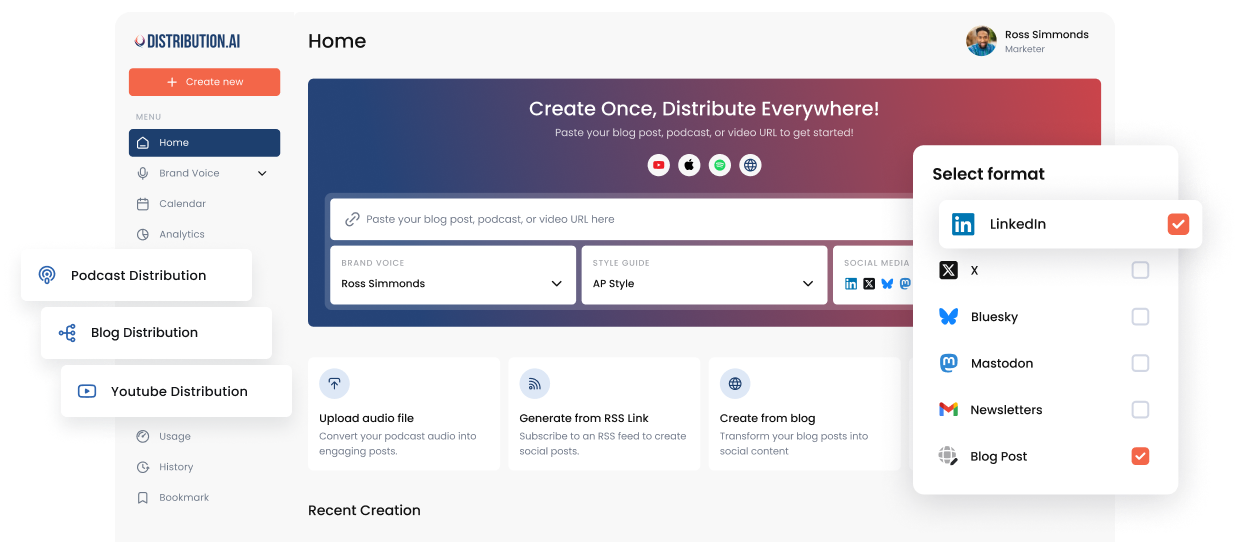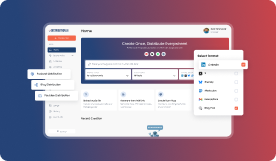What Is a Digital Strategy & How to Create One That Actually Works?
Learn how to create a digital strategy that drives growth. Discover steps, tools, and examples to plan, execute, and optimize your digital transformation.

Remember when Nokia was synonymous with mobile phones? Or when MySpace was the go-to social networking platform? Perhaps you recall Yahoo being the internet’s primary gateway.
These brands, once household names, dominated their industries. Yet, like Blockbuster and BlackBerry, their inability to adapt to digital innovation led to their decline.
The brands that thrive today are the ones that innovate, embrace change, and strategically integrate digital technologies into their business models. Think about how Netflix transitioned from DVD rentals to global streaming dominance, or how Amazon evolved from an online bookstore into the backbone of modern eCommerce.
A well-crafted digital strategy ensures you not only keep up with industry trends but also position yourself as an industry leader. This guide discusses how to create a digital strategy and practical ways to implement it in your business, backed by real examples.
What Is a Digital Strategy?
A digital strategy is a comprehensive plan that outlines how a business will leverage digital technologies to achieve its broader goals. It serves as a roadmap, detailing how digital initiatives align with the overall business strategy and drive measurable outcomes.
A successful digital strategy integrates digital transformation efforts across marketing, sales, operations, and customer service—ensuring that every function contributes to growth and efficiency. Its primary purpose is to enhance performance through digital means, such as expanding online presence, optimizing digital marketing strategy efforts, improving customer experience, and streamlining operations with new technology.
Why Do You Need a Digital Strategy?
Implementing a digital strategy offers several key benefits for any modern business:
Gives greater clarity and direction
Establishing specific, measurable business goals is the cornerstone of any effective digital strategy. Whether the aim is to increase sales, reduce operational costs, or enhance customer service, clearly defined objectives help guide your strategic efforts and resource allocation.
For example, instead of setting a vague goal like “increase sales,” set a target to “boost online sales by 15% over the next quarter.” A clear direction ensures every digital initiative aligns with your broader business strategy.
Creates competitive advantage
A good digital strategy equips businesses with the tools to stand out in competitive markets. By adopting innovative platforms and technologies, companies can deliver unique value propositions tailored to their audience’s needs. Whether it’s enhancing customer experiences, optimizing operations, or crafting impactful marketing campaigns, leveraging digital tools allows businesses to stay ahead of industry trends, gain market share, and foster enduring brand loyalty.
Enhanced customer engagement
An effective digital strategy allows brands to connect with customers through multiple digital channels, from social media platforms to email marketing and search engines. These touchpoints foster stronger relationships, improve satisfaction, and create consistent engagement across the customer journey.
Data-driven decision making
Using digital technologies helps businesses collect and analyze real-time data, leading to smarter, evidence-based decisions. It helps track key performance indicators (KPIs), ensuring teams can measure impact, optimize marketing activities, and continuously improve digital initiatives for long-term success.
How to Create a Digital Strategy?
Many people confuse digital strategy with a digital marketing strategy. In reality, digital strategy is broader, and digital marketing strategy is a part of it.
Along with digital marketing, digital strategy also involves digital transformation across other business functions. It helps organizations harness the right combination of technology, people, and processes to reach customers more effectively, adapt faster, and stay ahead.
Here’s a framework to help you plan, execute, and optimize your digital strategy:
Phase 1: Laying the foundation
Step 1: Define clear objectives
Define SMART goals with measurable outcomes and clear deadlines. For example:
- Increase website traffic by 20% in the next quarter
- Generate 100 qualified leads through social media campaigns within two months
- Achieve a 5% conversion rate from email marketing by year-end
These digital objectives should tie directly to your overall business goals and business strategy, ensuring every effort contributes to growth.
Step 2: Conduct an in-depth digital audit
A digital audit is the backbone of any successful digital transformation. It’s not just a surface-level review; it’s a full evaluation of your digital ecosystem:
- Website: Review design, UX, mobile responsiveness, SEO, and CRO. Tools like Google Analytics, SEMrush, and Hotjar reveal valuable data about visitor behavior. Clear reasons for website redesign, such as improving UX or conversions, keep your updates focused.
- Social media platforms: Assess your presence on each platform—engagement rates, audience demographics, content performance, and competitor analysis.
- Content marketing: Evaluate your content strategy, quality, frequency, formats, content distribution channels, and how well it supports your digital marketing goals.
- Technology & integrations: Map your tech stack, APIs, digital platforms, and third-party tools. Check integration gaps between CRM, ERP, WMS, and marketing systems.
- Data & analytics: Audit data sources, tracking quality, dashboards, and whether your analytics support actionable key performance indicators and decisioning.
- Business processes & operations: Identify manual handoffs, process bottlenecks, and opportunities to automate core business processes (order fulfilment, inventory, billing).
Step 3: Develop deep audience personas
Understanding your target audience is central to an effective digital strategy. Go beyond demographics and explore psychographics and online behaviors:
- Demographics: Age, gender, location, income, occupation
- Psychographics: Interests, values, and motivations
- Online behavior: Preferred digital channels, content consumption habits, and search intent
- Pain points and goals: What problems they’re trying to solve and the outcomes they want
Use tools like Google Trends, Facebook Audience Insights, and customer surveys to gather data. These insights should inform product, service, and experience design, along with marketing activities, to improve customer experience across touchpoints.
Phase 2: Building your tech stack
Step 4: Select the right digital tools, platforms, and processes
Based on your goals and audience insights, choose tools that fit your digital transformation strategy:
- Website optimization: Improve website design, UX, SEO, and CRO to attract and convert visitors. Consider A/B testing different elements to optimize performance.For educational websites, optimize design and UX, and use this list of top university websites as inspiration for effective layout and content.
- Content marketing: Use content creation tools, SEO platforms to create high-quality, valuable content that resonates with your audience and addresses their pain points.
- Social media marketing: Focus on the social media platforms where your audience is active. Use paid and organic tactics to expand reach and increase brand awareness.
Using social media marketing tools like Distribution AI to repurpose your existing content—blog, video, podcast—to generate social media content tailored to specific platforms. For example, carousels for LinkedIn, text posts for Twitter (now X), and infographics for Instagram. You can also schedule and publish posts, track analytics like engagement, click-through rates, top-performing content, and use the data to double down on what works.
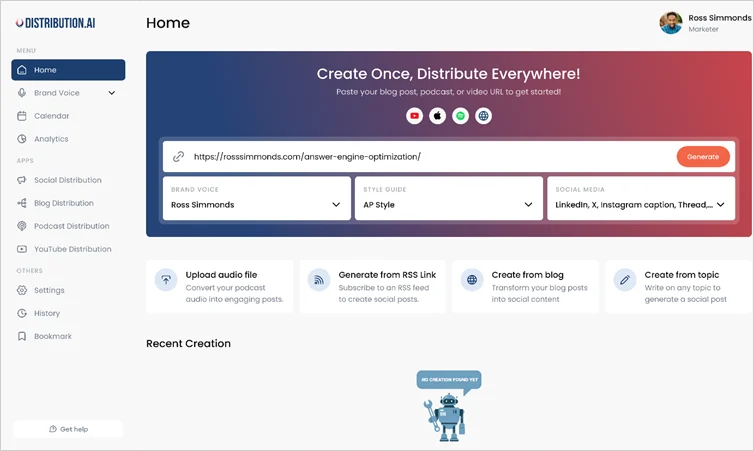
- Automation in operations: Invest in automation for both front- and back-office: marketing automation, order orchestration, WMS upgrades, and inventory/robotics where relevant.
- Marketing automation: Streamline repetitive tasks, personalize customer journeys, and improve efficiency with marketing automation tools like HubSpot, Marketo, and Pardot. Use social media automation tools to consistently post content on social media to drive awareness, generate leads, and boost conversions.
Selecting the right combination of tools ensures your digital initiatives support both short-term wins and long-term growth.
Phase 3: Execution and optimization
Step 5: Create an implementation roadmap
Your digital strategy needs structure to succeed. Build a clear roadmap covering:
- Timeline: Set realistic deadlines for each task and milestone. Use project management tools like Asana or Trello to stay organized.
- Budget allocation: Determine the financial resources required for each initiative. Track your spending and adjust as needed.
- Resource management: Assign roles and responsibilities to team members or external partners. Ensure everyone understands their tasks and deadlines.
- Progress tracking: Establish Key Performance Indicators (KPIs) to monitor progress towards your goals. Regularly review your progress and make adjustments as needed to achieve your business objectives.
This ensures your digital transformation projects stay organized, accountable, and aligned with strategic priorities.
Step 6: Measure and optimize based on data
Once your digital strategy is in motion, consistent measurement ensures that they are on the right track. Monitoring performance helps identify what’s driving results and where to improve.
So, continuously analyze your performance data to measure success and make informed decisions:
- Website analytics: Track website traffic, bounce rate, time on site, and conversion rates using tools like Google Analytics. These insights reveal how effectively your digital presence supports your business strategy.
- Social media analytics: Monitor engagement rates, reach, impressions, click-throughs, and conversions across social media platforms. Identify which campaigns drive the strongest outcomes and optimize future content.
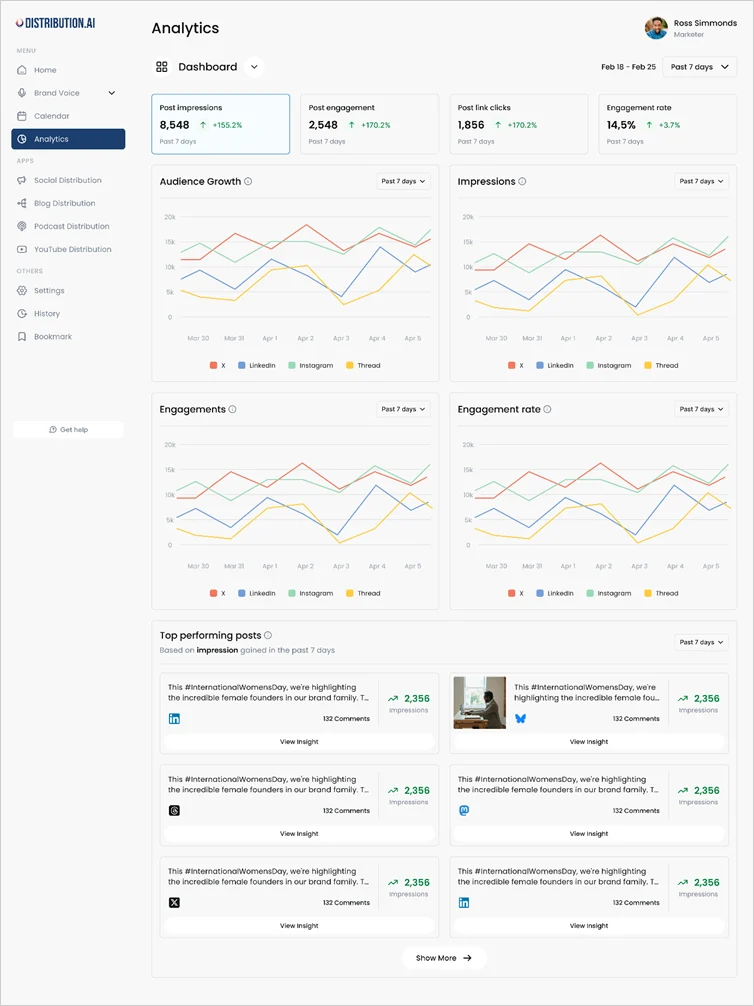
- Content marketing analytics: Evaluate page views, backlinks, keyword rankings, and organic traffic using tools like Google Search Console. Understand which topics and formats generate the most engagement and nurture leads.
- Email marketing analytics: Track open rates, click-through rates, conversions, and unsubscribes. Use A/B testing to refine subject lines and calls to action.
- SEM analytics: Measure impressions, cost per click (CPC), and return on ad spend (ROAS) to assess campaign efficiency and maintain a competitive advantage.
- Operational metrics: Monitor inventory accuracy, fulfilment time, downtime, and throughput to ensure operational efficiency.
- People & adoption metrics: Track training completion, tool adoption rates, time saved to see if your digital initiatives are actually delivering on business goals.
Pro Tip: Treat your digital strategy as a living document. Continuous learning, adaptation, and innovation will keep your business agile in a constantly changing digital environment.
4 Practical Ways to Implement Digital Strategies [With Examples]
Below are six ways you can follow to set your digital transformation strategy in motion across marketing, operations, culture, and tech.
1. Drive growth via a targeted digital marketing strategy
The first area that comes to mind when we say digital strategy is marketing. Implementing a digital marketing strategy lets you reach, persuade, and convert your target audience across digital channels. Here are a few ways to get started:
- Start with content marketing: Conduct keyword research, create relevant content that solves customer pain points, and optimize pages to attract qualified traffic.
- Establish social media presence: Focus on the social media platforms where your audience is most active. Share consistent, brand-aligned content, engage through comments and polls, and run marketing activities that increase brand awareness. Digital PR results can further amplify brand visibility by earning high-authority backlinks, media mentions, and improved search visibility, strengthening the overall digital marketing strategy.
💡Pro Tip: Using tools like Distribution AI helps you generate social media content in your brand’s voice within minutes. Thus, it saves you the hours spent on brainstorming, writing posts, and publishing them on different platforms.
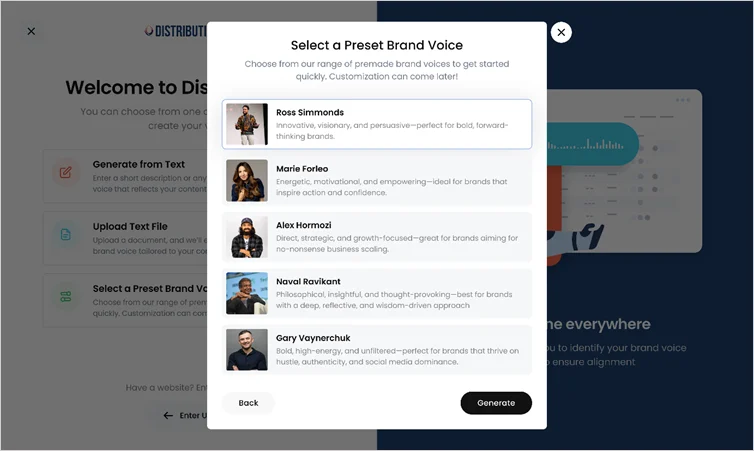
- Leverage email and automation: Use email marketing to nurture leads, send personalized recommendations, and move prospects through your funnel.
- Run paid campaigns strategically: Use digital ads on high-performing platforms to target specific audience segments and achieve measurable ROI.
Example:
HubSpot, a B2B software company, built growth around inbound marketing. By combining SEO-driven content marketing, social media marketing, and an automated email marketing strategy, it turned educational content into a steady lead engine—reducing reliance on ads and strengthening its competitive advantage within its broader business strategy.
2. Transform operations through digital technologies
A powerful digital strategy doesn’t stop at marketing. To create long-term impact, organizations must streamline workflows, digitize business processes, and integrate data-driven decision-making into everyday operations.
Here’s how:
- Automate routine processes: Use tools like Zapier, Make, or Power Automate to connect systems and reduce manual tasks.
- Digitize internal workflows: Move documents, approvals, and collaboration to digital platforms like Notion or Slack to improve agility.
- Adopt analytics tools: Build real-time dashboards to track KPIs and improve visibility across teams.
- Pilot digital transformation projects: Start small—automate one internal workflow, test its impact, and scale gradually.
Example:
Amazon introduced a new warehouse system called Sequoia (plus other robotics like Digit and Vulcan) that combines mobile robots, robotic arms, and AI to speed up how inventory is identified, stored, and processed. Amazon says Sequoia can identify and store inventory at fulfillment centers up to 75% faster and reduce order-processing time by about 25%,
3. Enhance customer experience through digital services
Every successful digital strategy puts customers at the center. Digital tools should make interactions smoother, faster, and more personalized across all digital channels.
Here’s how to make that happen:
- Personalize experiences: Use data and AI to recommend products or services based on past behavior.
- Improve accessibility: Build self-service portals, chatbots, and mobile-friendly sites that enhance user convenience.
- Integrate omnichannel touchpoints: Create consistency between your website, app, and offline touchpoints for a seamless journey.
- Monitor feedback: Collect reviews and use NPS tools to continuously improve the customer experience.
Example:
Sephora layered augmented-reality try-ons and a unified digital loyalty program (Beauty Insider) into its app and in-store experience to create seamless digital services across channels. The Virtual Artist AR feature (launched in 2016) lets customers try thousands of shades on their own faces, increasing engagement and reducing returns. Paired with Beauty Insider and personalized recommendations, these updates improved convenience, boosted conversions, and strengthened overall customer experience across digital channels.
4. Foster a digital-first company culture
Technology adoption succeeds only when people embrace it. An effective digital strategy includes building digital skills, creating accountability, and fostering collaboration across departments.
Here’s how to build it:
- Upskill teams: Train employees on new digital tools and data literacy.
- Promote ownership: Assign teams to manage priority initiatives and measure success through KPIs.
- Encourage cross-functional projects: Merge IT, marketing, and operations to promote knowledge-sharing and reduce silos.
- Reward innovation: Recognize teams that propose new digital initiatives or creative tech applications.
Example:
Adobe’s “Kickbox” program empowered employees to pitch, prototype, and launch new digital ideas. The result? Over 1,000 innovation pilots globally and a measurable boost in digital maturity and company culture.
Wrapping Up
An effective digital strategy starts with clarity—well-defined goals, the right mix of digital tools, and a focus on the customer. Set measurable KPIs and track metrics so you can learn, adapt, and grow.
For instance, if you’re planning a digital strategy, start with marketing. Build a solid digital marketing strategy, then create content that scales. Tools like Distribution AI help you repurpose blogs, videos, or podcasts into platform-ready posts, publish them, and track analytics to refine your strategy.
Treat your strategy as a living playbook: Iterate often, improve your digital maturity, and stay focused on outcomes. Experiment and close the loop between data and action to turn strategy into measurable results.
Want to learn more about Distribution AI?
Frequently Asked Questions
Promote, repurpose & distribute your content with AI
Start 15-Day Free Trial